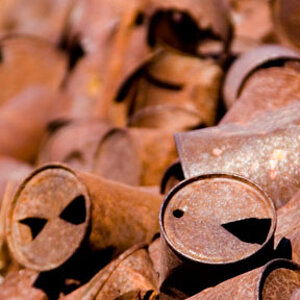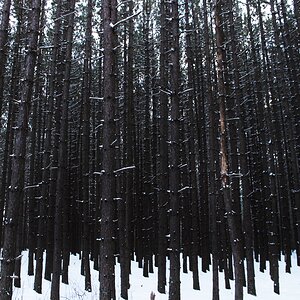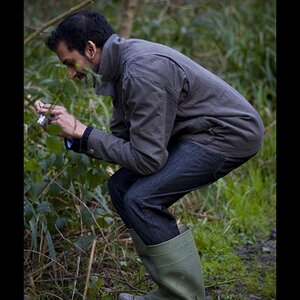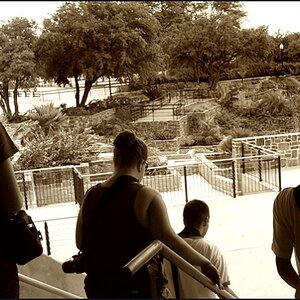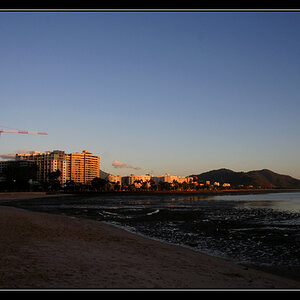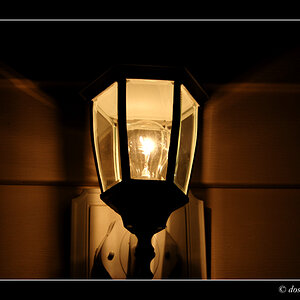Dave Colangelo
No longer a newbie, moving up!
- Joined
- Apr 27, 2016
- Messages
- 452
- Reaction score
- 158
- Can others edit my Photos
- Photos NOT OK to edit
I figured I would compile what I have found so far here to help others. If you shoot large format or need to check focus on a camera you may need some ground glass of an odd size, something you cant find on eBay or maybe you just like making things your self. Carrying around small sheets of glass in a bag, some are bound to break. Or maybe you want a custom pattern etc. I have been making my own replacements for about a year or so but since I don't use my 4x5 all that often its taken me a while to get through all the various methods. So heres what I have learned:
There are 3 methods I have found to grind glass (that seem to be popular around the interweb),
Sand Paper: First off this is by far the most time consuming. I used a variety of grits, brands, both wet and dry and all of them seem to have trouble scratching glass with any kind of efficiency and for that matter in any kind of coherent manner. For this you will need to make some kind of sanding block as hand pressure will lead to some very inaccurate grinding. Sand paper lead to the most inconsistent results across the board. If you start with a heavy grit the gouges will be quite deep but the time will be reduced. If you start with a fine grit you will be there for hours on end either trying to get a nice grind or trying to work out the deep gauge. The deep gauges made these sheets close to unusable more often than not, if you work it for a long time with the fine paper you can get workable results.
Chemical Etching: This is the best "in a pinch" solution. I was able to pick up the chemicals at my local art store which was quite nice. Time was this was a pretty quick one, it takes about 3 minutes to apply the goop then you just need to wait, wash it off and you are all good. This made some workable sheets with a few issues. The goop is a bit hard to apply evenly. I tried a few methods, brush, rag rub, pour and work around, pour till its coated, but in all cases it seemed to etch the surface somewhat unevenly. This could most likely be worked out with some more method experimenting. The uneven etching made for some harder to use sections as well as some really clean even sections. The sheet was workable but ultimately frustrating. Brightness was quite good and more than useable. When hitting it with a loupe you can really see the inconsistencies, when really trying to focus this caused an issue finding workable sharpness in some areas.
Silicone Carbide Powder: Thankfully amazon has made most stuff easy to get. Silicone carbide can be had for pretty cheap, this is the one I tested. This yielded by far the best results. Essentially you put a bit of powder on the glass, add some water to form a slurry then use another sheet of glass to work it around, applying even pressure as you go. The results from this were by far the most even across the panel and yielded the best panel under the loupe when focusing. All told this is the method to go with if you are choosing and have no bias on any front yet. It simply produces the best glass. I used 400 size powder which produced a bright useable glass. Id be curious to try 600 and 800 to see what results I get. If the mood strikes I may order more powder.
Another thing that helped quite a bit was to mask (tape) off the reverse side. This is something that not a lot of the instructions out there mention. I had some serious issues with slurry, chemicals or even just stray bits scratching the reverse side of the glass when trying to grind. A bit of tape fixed that nicely.
All the above methods cost around $10 for the supplies. Be it a jar of the etching chemical, a few sheets of sand paper or a bottle of silicone carbide. By volume it looks like the carbide will yield the most sheets per dollar. The glass is the same across the board so that cost is fixed.
A lot of stink seems to be made around grinding direction. All one way, linear than cross, circles then reverse circles, circles then cross etc etc. FWIW the etching and slurry methods are not really effected by this. The sand paper method, however, is. For no other reason then once deep gauges are cut in one direction its very hard to grind them out. Circles with the sand paper/finer grit seem to do well.
If anyone has any other methods that are not listed here Im all ears for trying something else.
There are 3 methods I have found to grind glass (that seem to be popular around the interweb),
- Sand Paper
- chemical etching
- Silicone Carbide powder (slurry method)
Sand Paper: First off this is by far the most time consuming. I used a variety of grits, brands, both wet and dry and all of them seem to have trouble scratching glass with any kind of efficiency and for that matter in any kind of coherent manner. For this you will need to make some kind of sanding block as hand pressure will lead to some very inaccurate grinding. Sand paper lead to the most inconsistent results across the board. If you start with a heavy grit the gouges will be quite deep but the time will be reduced. If you start with a fine grit you will be there for hours on end either trying to get a nice grind or trying to work out the deep gauge. The deep gauges made these sheets close to unusable more often than not, if you work it for a long time with the fine paper you can get workable results.
Chemical Etching: This is the best "in a pinch" solution. I was able to pick up the chemicals at my local art store which was quite nice. Time was this was a pretty quick one, it takes about 3 minutes to apply the goop then you just need to wait, wash it off and you are all good. This made some workable sheets with a few issues. The goop is a bit hard to apply evenly. I tried a few methods, brush, rag rub, pour and work around, pour till its coated, but in all cases it seemed to etch the surface somewhat unevenly. This could most likely be worked out with some more method experimenting. The uneven etching made for some harder to use sections as well as some really clean even sections. The sheet was workable but ultimately frustrating. Brightness was quite good and more than useable. When hitting it with a loupe you can really see the inconsistencies, when really trying to focus this caused an issue finding workable sharpness in some areas.
Silicone Carbide Powder: Thankfully amazon has made most stuff easy to get. Silicone carbide can be had for pretty cheap, this is the one I tested. This yielded by far the best results. Essentially you put a bit of powder on the glass, add some water to form a slurry then use another sheet of glass to work it around, applying even pressure as you go. The results from this were by far the most even across the panel and yielded the best panel under the loupe when focusing. All told this is the method to go with if you are choosing and have no bias on any front yet. It simply produces the best glass. I used 400 size powder which produced a bright useable glass. Id be curious to try 600 and 800 to see what results I get. If the mood strikes I may order more powder.
Another thing that helped quite a bit was to mask (tape) off the reverse side. This is something that not a lot of the instructions out there mention. I had some serious issues with slurry, chemicals or even just stray bits scratching the reverse side of the glass when trying to grind. A bit of tape fixed that nicely.
All the above methods cost around $10 for the supplies. Be it a jar of the etching chemical, a few sheets of sand paper or a bottle of silicone carbide. By volume it looks like the carbide will yield the most sheets per dollar. The glass is the same across the board so that cost is fixed.
A lot of stink seems to be made around grinding direction. All one way, linear than cross, circles then reverse circles, circles then cross etc etc. FWIW the etching and slurry methods are not really effected by this. The sand paper method, however, is. For no other reason then once deep gauges are cut in one direction its very hard to grind them out. Circles with the sand paper/finer grit seem to do well.
If anyone has any other methods that are not listed here Im all ears for trying something else.
Last edited:
As an Amazon Associate we earn from qualifying purchases.


